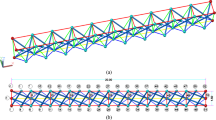Abstract
The conventional linear quadratic regulator (LQR) control algorithm is one of the most popular active control algorithms. One important issue for LQR control algorithm is the reduction of structure’s degrees of freedom (DOF). In this work, an LQR control algorithm with superelement model is intended to solve this issue leading to the fact that LQR control algorithm can be used in large finite element (FE) model for structure. In proposed model, the Craig-Bampton (C-B) method, which is one of the component mode syntheses (CMS), is used to establish superelement modeling to reduce structure’s DOF and applied to LQR control algorithm to calculate Kalman gain matrix and obtain control forces. And then, the control forces are applied to original structure to simulate the responses of structure by vibration control. And some examples are given. The results show the computational efficiency of proposed model using synthesized models is higher than that of the classical method of LQR control when the DOF of structure is large. And the accuracy of proposed model is well. Meanwhile, the results show that the proposed control has more effects of vibration absorption on the ground structures than underground structures.
Similar content being viewed by others
References
LIU X D, WU Y J, ZHANG Y, XIAO S. A control method to make lqr robust: A planes cluster approaching mode [J]. International Journal of Control, Automation, and Systems, 2014, 12(2): 302–308.
HUI Q. Distributed semistable LQR control for discrete-time dynamically coupled systems [J]. Journal of the Franklin Institute, 2012, 349: 74–92.
TAO C W, TAUR J S, CHEN Y C. Design of a parallel distributed fuzzy LQR controller for the twin rotor multi-input multi-output system [J]. Fuzzy Sets and Systems, 2010, 161: 2081–2103.
TARAPAD A R, DEBABRATA C. Optimal vibration control of smart fiber reinforced composite shell structures using improved genetic algorithm [J]. Journal of Sound and Vibration, 2009, 319(1/2): 15–40.
BASU B, NAGARAJAIAH S. A wavelet-based time-varying adaptive LQR algorithm for structural control [J]. Engineering Structures, 2008, 30(9): 2470–2477.
POODEH M B, ESHTEHARDIHA S, KIYOUMARSI A, ATAEI M. Optimizing LQR and pole placement to control buck converter by genetic algorithm [J]. Control, Automation and Systems, 2007, 17/18/19/20: 2195–2200.
POURZEYNALI S, LAVASANI H H, MODARAYI A H. Active control of high rise building structures using fuzzy logic and genetic algorithms [J]. Engineering Structures, 2007, 29(3): 346–357.
JIANG Z, HAN J D, WANG Y C, SONG Q. Enhanced LQR control for unmanned helicopter in hover [J]. Systems and Control in Aerospace and Astronautics, 2006, 6: 1437–1443.
TODOROV E, SAN D C, LI W W. A generalized iterative LQG method for locally-optimal feedback control of constrained nonlinear stochastic systems [J]. American Control Conference, 2005, 1: 300–306.
TAYFUN C, STEPHEN P B. Global optimal feedback control for general nonlinear systems with nonquadratic performance criteria [J]. Systems & Control Letters, 2004, 53(5): 327–346.
SAM Y M, OSMAN J H S, GHANI M R. A class of proportional-integral sliding mode control with application to active suspension system [J]. Systems & Control Letters, 2004, 51(3/4): 217–223.
ADELI H, KIM H. Wavelet-hybrid feedback-least mean square algorithm for robust control of structures [J]. Journal of Structural Engineering, 2004, 130(1): 128–137.
KIM H J, ADELI H. Hybrid feedback-least mean square algorithm for structural control [J] Journal of Structural Engineering, 2004, 130(1): 120–127.
VADIGEPALLI R. A distributed state estimation and control algorithm for plantwide processes [J]. Control Systems Technology, 2003, 11(1): 119–127.
KIM S, CHU B, HONG D, PARK H K. Synchronizing dual-drive gantry of chip mounter with LQR approach [J]. Advanced Intelligent Mechatronics, 2003, 2: 838–843.
TRINDADE M A, BENJEDDOU A, OHAYON R. Piezoelectric active vibration control of damped sandwich beams [J]. Journal of Sound and Vibration, 2001, 246(4): 653–677.
LI Q S, LIU D K, FANG J Q, TAM C M. Multi-level optimal design of buildings with active control under winds using genetic algorithms [J]. Journal of Wind Engineering and Industrial Aerodynamics, 2000, 86(1): 65–86.
BOER S E, AARTS R G K M, MEIJAARD J P, BROUWER D M, JONKER J B. A nonlinear two-node superelement with deformable-interface surfaces for use in flexible multibody systems [J]. Multibody System Dynamics, 2014, 31: 405–431.
PAUL L C V, DANIEL J R. An impulse based substructuring method for coupling impulse response functions and finite element models [J]. Computer Methods in Applied Mechanics and Engineerging, 2014, 275: 113–137.
FEHR J, EBERHARD P. Simulation process of flexible multibody systems with non-modal model order reduction techniques [J]. Multibody System Dynamics, 2011, 25: 313–334.
MOURELATOS Z P. An efficient crankshaft dynamic analysis using substructuring with ritz vectors [J]. Journal of Sound and Vibration, 2000, 238(3): 495–527.
ALBERTO C. Superelements modelling in flexible multibody dynamics [J]. Multibody System Dynamics, 2000, 4: 245–266.
NORTIER B P, VOORMEEREN S N, RIXEN D J. Application of residual vectors to superelement modeling of an offshore wind turbine foundation [J]. Topics in Experimental Dynamics Substructuring and Wind Turbine Dynamics, Conference Proceedings of the Society for Experimental Mechanics Series, 2012, 2: 149–163.
GUO J, CHEN J Y, BOBET A. Influence of a subway station on the inter-story drift ratio of adjacent surface structures [J]. Tunnelling and Underground Space Technology, 2013, 35: 8–19.
Author information
Authors and Affiliations
Corresponding author
Additional information
Foundation item: Project(LZ2015022) supported by Educational Commission of Liaoning Province of China; Projects(51138001, 51178081) supported by the National Natural Science Foundation of China; Project(2013CB035905) supported by the Basic Research Program of China; Projects(DUT15LK34, DUT14QY10) supported by Fundamental Research Funds for the Central Universities, China
Rights and permissions
About this article
Cite this article
Xu, Q., Chen, Jy., Li, J. et al. Study on LQR control algorithm using superelement model. J. Cent. South Univ. 23, 2429–2442 (2016). https://doi.org/10.1007/s11771-016-3302-y
Received:
Accepted:
Published:
Issue Date:
DOI: https://doi.org/10.1007/s11771-016-3302-y




